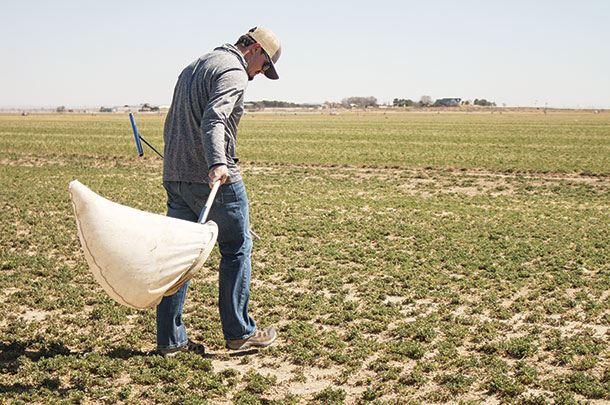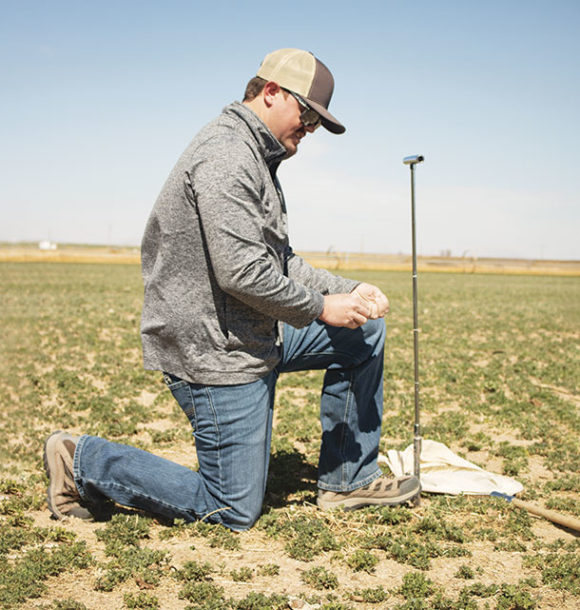University researchers are testing methods for controlling herbicide-resistant weeds at harvest. Currently, there are two options – the first is a high-impact cage mill (weed seed destructor) that destroys seeds coming out the back of the combine, and the second is a chaff liner that installs on the back of the combine to concentrate all weed seed-bearing chaff into a narrow windrow behind the combine instead of spreading it across the full width of the platform.
Studying both options
Vipan Kumar, assistant professor of weed science at Kansas State University, is working with researchers at Iowa State University and University of Arkansas on a USDA-NIFA-funded project to study both options.
These methods have shown promising results in grain thus far, but Kumar says they are not a replacement for other weed management methods, especially herbicides, but should be integrated with herbicides and cover crops.
“It’s not a silver bullet,” he says.
Still, he believes they can be an effective tool as part of a program, since they can reduce the number of seeds that get added to the seedbank from escapes each year.
“It’s going to be a good component of integrated weed management,” he says.
The study will compare the weed control effectiveness between the high-impact mill and chaff line with or without a cereal rye cover crop over the next few years. The goal is to provide data to farmers so they can make decisions from a profitability and sustainability standpoint. Kumar says they are planning to work with an ag economics expert to develop a cost-benefit analysis to give recommendations to growers.
 Dalton Hahn runs preliminary checks for weeds and pests for the upcoming growing season on an alfalfa field. Photo by Joy Hendrix.
Dalton Hahn runs preliminary checks for weeds and pests for the upcoming growing season on an alfalfa field. Photo by Joy Hendrix.
From initial tests, the high-impact mills are quite effective at damaging weed seeds so they will not germinate next season.
Study specifics
Prashant Jha, associate professor and extension weed specialist at Iowa State University, has data from 2020 and 2021 testing the mill on herbicide-resistant waterhemp in soybeans.
“I think it’s a great tool for minimizing seedbank inputs at the end of the season,” he says.
The mill successfully crushes about 92% of the waterhemp seeds that go through it. Unfortunately, only about 65% to 70% of the waterhemp seeds make it to the mill because there is significant header loss from shattering, and some weed seeds go into the grain tank.
Jha says they will be testing different platform types like air reels to maximize the number of weed seeds that make it into the combine and through the mill instead of falling onto the ground.
Since waterhemp and Palmer amaranth can have 200,000 to 500,000 seeds or so, Jha says the header loss is a significant amount of seeds to be skipping the mill.
Chaff lining does not directly destroy seeds, but by concentrating the chaff and weed seeds into a narrow band about 2 feet wide, it enables other control methods such as a banded or shielded herbicide applications, according to Jha. Additionally, Kumar says the chaff line also functions as a mulch to reduce weed seed germination and emergence.
Cost breakdown
Both technologies have been used commercially in Australia for almost half-a-dozen years and are just starting to be tested in the U.S.
While Kumar says the price of the high-impact mill is likely to go down as manufacturing ramps up in North America, the current price is about $75,000 for the mill made by Redekop company in Canada. The chaff lining kit, imported from Australia, costs $6,000 to $7,000. Jha describes the chaff lining kit as a simple baffle to separate chaff from the straw and a narrow chute to lay the chaff in a narrow windrow.
The high-impact mill manufactured by Redekop can only be used on newer John Deere combines (S680 or newer models).
With the high cost and combine requirements needed for the mill, Jha says only very large operators seem to have the scale to see the financial benefits fast enough to make the investment right now. For farmers managing a thousand acres or more, needing a third pass of herbicides in soybeans quickly adds up, so the mill could likely pay for itself in just a few years.
Chaff lining is more affordable, and Jha has seen some smaller producers and organic growers leaning that direction.
Overall, he is seeing many farmers looking into both options to address the growing weed control challenges of herbicide resistance.
“There’s a lot of interest,” Jha says.
Future applications
Chaff lining is most effective in small-grain and soybean crops, and less so for corn and grain sorghum because of the nature of the chaff from those two crops, he says.
While the high-impact mill is being tested primarily in soybeans right now, Jha thinks it could be used effectively in a large number of crops, like corn, soybeans, grain sorghum, cereals and forage crops.
In addition to crushing weed seeds, Kumar says the mill could also prove effective to prevent volunteer wheat that comes from harvest loss – the mill can crush the wheat seeds as well as the weed seeds. It could also possibly be used at corn harvest to prevent volunteer corn in the next year’s soybean crop. Jha says they are planning to test the mill at corn harvest in the 2022 harvest season.
Kumar and Jha both say there are no direct applications to the forage world right now, but the chaff line and roller mill systems could be used in the grain crop part of a grain and forage rotation to reduce the weed seedbank to benefit subsequent forage crops that do not have much herbicide options.
In addition, forages themselves are an additional helpful part of managing weeds because of the regular mowing.
“Having a forage crop in the rotation is by itself an integrated weed management approach,” Jha says. “That’s another tactic in the toolbox to manage weeds.”











